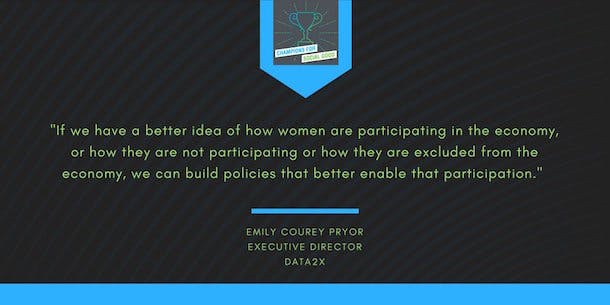
This March, a spotlight is shining on the role of women in the workplace. The conversation launched on International Women’s Day (March 8) with the theme “Women in the Changing World of Work: Planet 50-50 by 2030,” and discussions will continue throughout the 61st UN Commission on the Status of Women (March 13-24), which is focusing on “Women’s economic empowerment in the changing world of work.”
The Sustainable Development Goals have brought renewed interest in the issue of women and work. The premise? Achieving the bold promises of these goals requires that women be full and active participants in the workforce.
Data2X asserts that while women’s economic empowerment is necessary to achieve the Sustainable Development Goals, we need improved gender data to achieve women’s economic empowerment.
This is because without complete, accurate, and unbiased data about women’s economic contributions, including data describing the barriers women can face when trying to work, it is impossible to design policies that enable our full economic participation and empowerment.
Uruguay’s National Care Policy offers a vivid example. One of the major barriers to entering (or staying) in the workforce faced by women in Uruguay, and indeed elsewhere around the globe, is time constraints. In Uruguay, there was a general and intuitive recognition that women spent much more time engaging in unpaid care work (including care of children and the elderly) than men, thus inhibiting women’s participation in the formal economy. However, without official data highlighting this issue, there was little evidence to spur policy change.
So, first in 2003, and again from 2007-2013, academics and then the National Statistics Office in Uruguay collected time use data, both in the capital city, Montevideo, and across the country, to provide evidence on gender inequity in time spent in unpaid care work. They found that although men’s time spent on unpaid work increased since 2007 (from 15.8% to 19.5%), women continuously spent about 37% of their time on unpaid care.
Using this gender data, civil society and academia pushed their government to put this issue on the national policy agenda and advocated for change. And, in late 2015, Uruguay’s National Care Policy was born. This policy provides care for preschool children, the elderly, and people with disabilities. It is early to see how this new policy will impact women’s economic participation, but given the stark gender difference in time spent on unpaid care work previously, it is reasonable to imagine the potential that this type of policy can have for women’s paid working lives in Uruguay.
“When women are full participants in the workforce, we see dynamism and growth,” said Amina Mohammed, UN Deputy Secretary-General, at UN Women’s celebration for International Women’s Day last week. We couldn’t agree more!
Dynamic and growing economies require measurement to track and prove their growth and vitality, but also to go one level deeper – to understand what hinders or accelerates their growth.
This is the exciting arena that gender data plays in; understanding the differential participation of women and men in economies, why those differences exist, and how data can be used to help build the right environment for healthy and equal opportunities for women to be paid, and for their contributions in all aspects of life – maternal, financial, political, and philosophical – to be fully seen, maximized, and valued.
Data2X, a platform for partnerships on gender data, is proud to be working in partnership with the International Labour Organization, the World Bank, and the Food and Agriculture Organization to refine measures for counting women’s work and employment.
This March, from International Women’s Day through the Commission on the Status of Women, we applaud the focus on women’s economic empowerment, and we also urge leaders to recognize that this laudable goal will only be possible with improved data about women’s economic participation.

